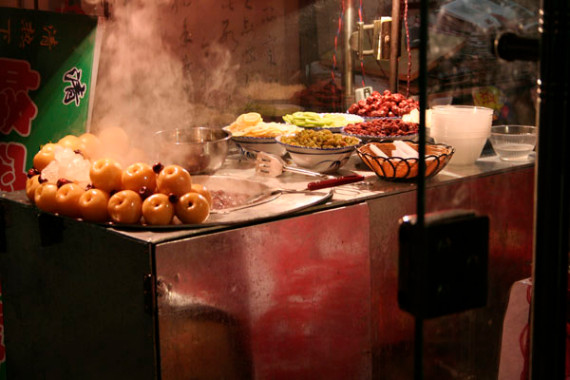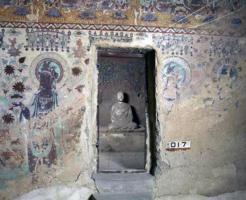Join-in Group Silk Road China Tours
About Us | Contact us | Tourist Map | Hotels | Feedback
Food in Xian

Overview:Xian dining & eating guide for tourists to the best local food, restaurants, cuisine cooking recipes, drink, menu dishes such as Roast Duck, imperial Dishes, snacks, Western, vegetarian food in Xian ...
Shaanxi Cuisine, also known as Qin Cuisine, is the representative culinary achievement in the northwest China. In comparison to other Chinese cuisines, it is outstanding in three aspects. Firstly, due to Shaanxi's geographical location in the center of China, various kinds of materials deriving from both north and south China are adopted. Second is the special cooking skills of the local chefs, including Tun (deep-fry), Qiang (fry quickly in hot oil, then cook with sauce and water), Chao (stir-fry), Zheng (cook by use of steam), Dun (braise) and so on. Finally is its frequently use of salt, vinegar, capsicum and garlic, making the savory flavor of sour, spicy and fragrant.
What to eat
Xi'an specialties include:
Yang Rou Pao Mo is one of the signature dishes of the area: it consists of a piece of thick, chewy bread and a kettle of mutton soup. The diner shreds the bread with his hands and places the shreds in a bowl, the soup is then poured over the shreds (along with meat, maybe some noodles or scallion, etc.) The trick is to shred the bread into pieces that are "as small as possible". Most first-timers will shred their bread in pieces that are too large. In some restaurants, they have already shredded the bread for you. It is normally also served with pickled garlic and chili. If you don't like mutton, some restaurants also offer a beef (niu rou) version. Tong Sheng Xiang Restaurant and the Lao Mi Jia are recommended.
Biang Biang Mian is a local provincial specialty noodle dish that is extremely good. The wide noodles are spiced, have a broth, and include toppings such as eggs, tomatoes, beef, etc. The character for "biang" isn't yet possible to type into a computer, but look for a complex character with about 57 strokes repeated twice before "flower". A popular chain has a red sign with white characters, and includes the face of the "Noodle King".
Rou Jia Mo is the closest thing to a beefburger. This is a local tradition and should be very easy to locate. Sandwich-like, with pork, beef or lamb, this is a must-try item for anyone who is in this area.
Xiao long bao-zi are basket-steamed dumplings (one basket ¥3), common as a midnight snack. Look for its big brother "Da bao-zi" only available first thing in the mornings, like a steamed cornish pastie, but very nice.
Guan Tang bao-zi are steamed buns served with sauces inside.
Shi Zi Bing are buns made from persimmons, stuffed with something (e.g. black sesame paste), and deep-fried, so they're quite sticky-sweet. You can find many sellers in the Muslim Quarter, and they are only ¥1 each!
Lu dou gao are literally green bean cakes (come in small cubes), but they're more moist than you may find elsewhere and also come with a variety of mixings (e.g. sesame). Half a Jin should be about six cubes and cost about ¥5 at a cart in the Muslim Quarter.
Where to eat
Some good places to look for restaurants are:
The Muslim Quarter close to the Drum Tower is a vibrant area with many restaurants spilling out onto the street and mixing with the street sellers. If you're looking for snacks, this area is also full of people selling dried fruit (especially dates) and nuts/seeds (sunflower, melon, pumpkin, etc.) Prices are per Jin (500 g) and are pretty much standardized throughout the area, so you can't really bargain unless you're buying a lot. Watch out for the pits in the jujube!
Street food (mostly sold after sunset, or some near night clubs/bars after 11:00 PM) presents a variety of local/regional dishes, ranging from noodle soups, dumplings, hot pot, and so on by tens of little food vendors on street side, each with a red lamp. There are a few roads running perpendicular to the Muslim Quarter road that have a larger variety of streetside food (at cheaper prices because these roads are harder to access). As streetside stores are nearly a model of perfect competition, look out for food sold at significantly higher prices, yet maintain a long queue as these are likely to be tastier. For instance, some vendors may unscrupulously sell beef mixed with lamb and pass the meat off as pure lamb meat to cut their cost, however those who sell real lamb meat usually charge a higher price.
A good way if you do not want the expensive hotel food or just want to try real Chinese cuisine, is to simply go into a small restaurant and point to a dish somebody else is having and you will get a meal for less than ¥10 (seldom ¥20) per person.
A good street for eating is Xiyang Shi running east-west near the mosque in the Muslim quarter. However, be warned that the food that is sold may have been exposed to heat and sun for a longer period of time without cooling, so particularly meat, fish or egg products may cause trouble to Western stomachs that are not accustomed to this.
Wen Xin Jiaozi Guan, 123 Xushimiao Street (Next to the Good World Hotel, off of Lian Hu Lu). A good cheap place for jiaozi (Chinese dumplings). There is no menu, but endless supplies of fresh jiaozi of many flavors. From ¥4-5 a bowl.
Lao Sun Jia, G/F Dong Dajie. Has fantastic yangrou paomo which is very cheap but flavoursome. No English spoken but easy to communicate with sign language! At this time you can only find a mound of fresh rubble at the original site of the restaurant, also as currently wrongly indicated in GoogleMaps as a duplicate site. The right place of the two indicated is the one at NW position. The new site is very near to the original place, diagonal on the other side of the intersection. Look for a modern new building with a big signpost.


